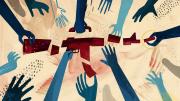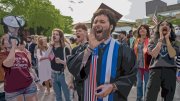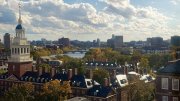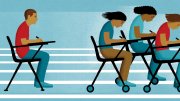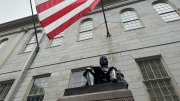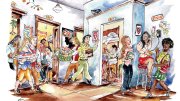I spent my July Fourth listening to fireworks instead of watching them. I had opted for a nighttime walk through Danehy Park, just a few blocks north of the Radcliffe Quadrangle. During the school year, it had given me refuge during all manner of academic woes and social blues, from midterms to fallings-out with friends. On this summer evening, I hoped the park, and the anonymity it provided, would shield me from something else.
As the orange sky darkened to blue, I began to hear faint, distant fireworks snapping to a distracted rhythm. The park was removed from any ideal viewing spot, which meant I was far away from the crowds and couldn’t actually see the fireworks. That was partly why I had chosen it; given the recent spate of highly publicized mass shootings, I was looking for peace. Still, without the visual accompaniment to the unsteady percussion, I realized I couldn’t actually be sure those were fireworks at all. Somewhere else in the United States, earlier in the day, they hadn’t been; for parade-goers in Highland Park, Illinois, the popping sound had been gunshots, which left seven dead and dozens injured.
Americans have become increasingly wary of gun violence. And with good reason. For young people, who have grown up seeing bullets kill fellow classmates, gun violence has played a part in forming generational bonds. We have become another cohort united by shared experience, knowledge, and fear. And we take our place in a long list of such generational cohorts, solidified in the wake of shootings like Columbine and Newtown; we, the college-aged students of the United States, have become the Parkland generation.
Of course, there had already been numerous school shootings before February 2018, when a gunman at Marjory Stoneman Douglas High School in Parkland, Florida, took 17 lives. And there were more shootings afterward. But for those now in college, at Harvard and elsewhere, that is the foundational shooting.
In part, that’s because we were old enough to understand what happened. I was a junior in high school that year. It made gun violence real to every high schooler in the nation. “I remember coming home after Parkland and sitting home on Valentine’s Day, pulling up a chair, and just watching the TV for three hours, with the news talking about this horrible, terrible mass shooting,” said Jack Kelly ’26, an incoming first-year at the College. He soon became involved in March for Our Lives, a student-led movement for gun control founded after Parkland, and now leads state-level programming in New York.
As the junior class president of Marjory Stoneman Douglas, Jaclyn Corin ’23 lived the reality that Kelly saw on screen. She noted that Parkland had been voted one of the safest communities in Florida for multiple years in a row. If it could happen there, it could happen everywhere—and it has been happening everywhere.
We were old enough not only to understand, but also to speak out in public. The result was a national protest on March 24, 2018—the first I ever attended. (Called March for Our Lives, that event grew into the organization of the same name.) My parents, usually concerned about the safety of protests, let me go.
The students who led March for Our Lives—and those who followed them—are now in college. Some are at Harvard. On campus, those student leaders have become icons of activist stardom, but they also embody a sense of collective grief, exhaustion, and relentless effort that resonates across our student body.
Gun violence affects how we look at the world in ways that seep beyond news coverage and protests. For many young people, a step outside comes with a storm of questions. “You can’t help but walk into a public place and just be more cognizant of the fact that gun violence is a thing,” Kelly said. “You’d be sitting in the movie theater, and it has to cross your mind at least once—or at least that’s me. And I feel like it’s a generational thing. ‘Where’s the exit? Where’s the closest place? What do I do in case of an emergency?’”
For Maddy Ranalli ’24, a gun safety activist who co-founded the Boston chapter of March for Our Lives in 2018, these questions partly shape a larger shared psyche. “Our generation has been dubbed the ‘school shooting generation,’ the ‘gun violence generation,’ and I think there’s a degree of collective consciousness with that. We just grew up with active shooter drills and hearing about things like Sandy Hook when we were little, and it never really stopped since then,” Ranalli said. “It’s baked into our memories.”
The constant potential for violence has left students on edge. Earlier this year, when bomb threats upset the campuses of Yale, Dartmouth, and Princeton, anxiety permeated Harvard as well. The threats were discovered to be just hoaxes, and the flurries of student messages soon returned to more prosaic concerns about midterms and club meetings. Still, that ripened fear hung low enough to drop at any moment. In our country—regularly engulfed by mass death, and where the leading cause of death among young people remains gun violence—we know that threats of violence can become reality.
“I genuinely don’t know a person that has not had any moments in their life where they feared being shot,” said Corin, “whether they hear a loud noise in the street, or they hear that there’s a code red somewhere in their community and they don’t know what to expect. This happens all the time.”
And those fears have sometimes become reality. My father was working as a physician at Bronx Lebanon Hospital Center on the day an active shooter entered the building in 2017. The shooter left one doctor dead and six other medical personnel wounded, as New York police officers flooded in and evacuated the building. After waiting outside the hospital for 30 minutes while police cleared the scene, my father went back inside to operate on a medical student injured in the attack. My mother and I kept our eyes on the helicopter footage on television until we knew he was safe. Gun violence has transformed spaces of refuge—hospitals and schools, which care for the wounded and the young—into spaces of destruction.
This change has produced new markers and rituals. Nowhere are these more pronounced than in the K-12 schools. On each visit back to my old high school, I find more security measures than in the year before: enhanced visitation protocols, locked doors, a new security guard stationed at the main entrance. Active shooter drills have become monotonous, and one of my former teachers remarked that the protests following Uvalde felt tepid.
In college, a far less sheltered yet generally safe environment, we go about our days without interruption, awaiting the next message from the Harvard University Police Department about suspicious activity. Still, I and others I know have gotten into a habit of marking the geographic layout of whatever place we’re in. As I enter the Science Center, I sketch out my distance from various points: the three exits that flank the back end of the building, the network of tunnels in the basement that lead eventually to the outdoors, and the revolving doors up by the front. More than once, I have run through different scenes in my head, wondering where I would go and what I would do if someone showed up with a gun.
There are many such generational cohorts. Just as there is a Parkland generation, there is also a Sandy Hook generation, now in high school, perhaps beginning to more fully comprehend the trauma their community underwent in 2012. A Virginia Tech generation is now reaching the middle of adulthood. A Columbine generation, now parents themselves. There are generations we haven’t even named. A Red Lake generation of Indigenous adults still mourning the 2005 loss of their fellow students and tribal officers in what was, at the time, the largest school shooting since Columbine. A 49th Street generation of individuals in middle age, grappling with the 1984 elementary school shooting that left two classmates dead and twelve wounded in a majority-Hispanic and economically impoverished neighborhood.
Still, calling gun violence a strictly generational issue would be a mistake. There are countless shootings that don’t result in widespread generational movements. Gun violence is a fixture of many urban and poor neighborhoods, where mass shootings—defined by Congress as any incident in which three or more individuals are killed within a public space—accumulate as a piecemeal massacre day by day. This violence is traumatic and damaging to young people, yet frequently goes undiscussed; as The Journal of the American Medical Association reported, young people living in impoverished areas can be more than four times as likely to die from gun violence than those from wealthy areas.
RuQuan Brown ‘23, originally from Washington, D.C., grew up in one of those impoverished areas. “I can’t speak for the whole generation. I can speak for people in the poorest neighborhoods in America. And I can say that we have been traumatized,” he said. “And there’s a part of our brain…that remembers trauma.” Brown’s stepfather was murdered in 2018, and a teammate on his high school football team a year earlier. His father shared his own stories of growing up amid violence in East Oakland: “I was even born with trauma from my father.” Brown went on to establish the clothing brand Love1 and the Love100 Project, both of which focus on impoverished areas by covering funeral costs for victims, securing mental health therapy for youth, and one day, Brown plans, financing college for young people.
Gun violence, then, is not new for all members of our generation. But it has for the first time broadly united young people across geographies, socioeconomic strata, and racial lines—in part reflecting the growing realization that shootings can occur anywhere. As Brown pointed out, while gun violence has constituted part of his reality since age five, many of his College classmates only recently began to see it as something other than an ingredient of Hollywood dramas. But he does not believe that disparity in experience is cause for division in the movement. “We’re united by the fact that we’re afraid of losing our lives, and we’re mourning the losses that we’ve experienced. We don’t need anything else to unite us for that.”
While we may be united by this common fear, forging unity on ideological grounds is more difficult. In middle school, I lived for a year in suburban Pittsburgh, where gun culture held deeper sway. Students regularly talked about their exploits at the shooting range. In New Jersey, where I attended high school, that culture was not absent, only quieter. When the Parkland shooting prompted walkouts in my school and across America, there remained a sizable slice of students who staged a pro-gun-rights sit-in in the auditorium. Some of my classmates looked on in disbelief, almost with a feeling of betrayal, as they recognized people they knew in a video that surfaced afterward.
Harvard, with its diverse student body, reflects this fraught mixture of opinions. During orientation week my freshman year, I was sitting in Annenberg dining hall with my Wigglesworth Hall entryway mates. A small argument about gun violence arose. One student decried the prevalence of mass shootings, calling for stricter background checks and restrictions on the types of guns available to the public. Another, who had grown up hunting, defended his way of life: “But when you hold a gun in your hands and shoot an animal, it just feels so good.” The conversation reached a standstill.
As we move from stalemate to incremental progress, many of the kids who survived mass shootings wonder when our stop-motion approach to gun safety will give way to genuine animation.
Kelly is optimistic that the answer will come. Pointing to the activism efforts of the 1960s and ’70s, he said, “You look back at that generation, and it was civil rights. It was the early fight for abortion rights, for women’s rights, for the rights of LGBTQ people. That was their generation.”
He identified the issue of gun violence as our generation’s wake-up call, one that will finally inspire political action.
